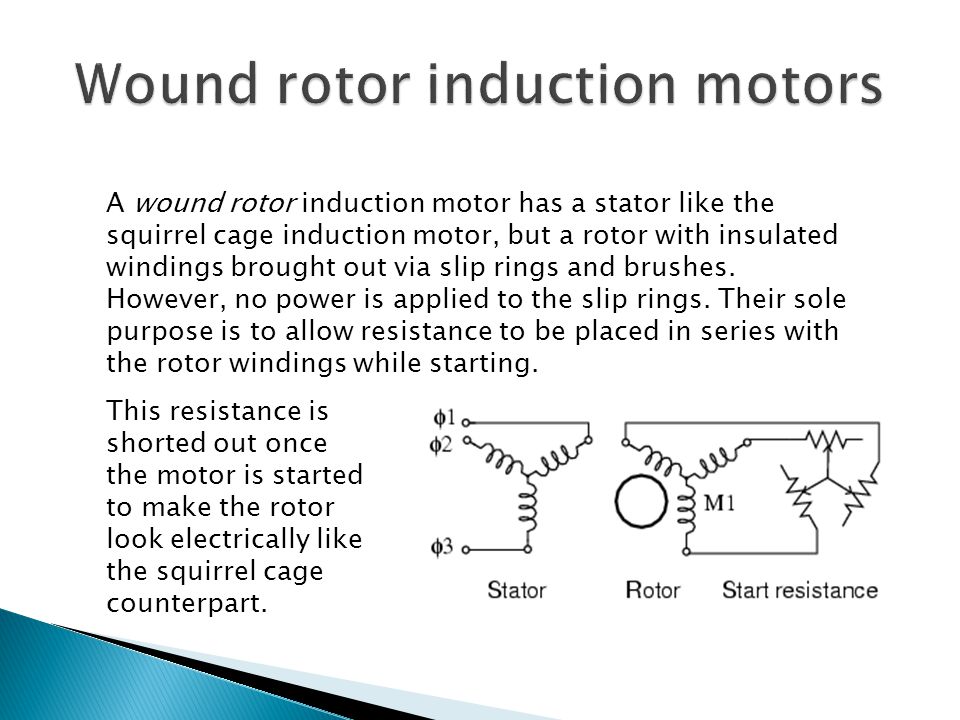
Difference Between Squirrel Cage And Wound Rotor Induction Motor Pdf
A wound rotor induction motor has a stator like the squirrel cage induction motor, but a rotor with insulated windings brought out via slip rings and brushes. Parts of an Induction Motor. An induction motor has 2 main parts; the Stator and Rotor. Ms office 2010 free download utorrent.
Table of Contents • • • • • • • Fig.1 Squirrel Cage rotor • In Squirrel cage induction motors the rotor is simplest and most rugged in construction. • Cylindrical laminated core rotor with heavy bars of copper or Aluminum is used for conductors. • Rotor conductors or rotor bars are short-circuited with end rings.
• Rotor bars are permanently short-circuited and hence it is not possible to connect an external resistance in the circuit in series with the rotor conductors. • It has low cost. • There are no moving contacts in the rotor. • Higher efficiency. • Low starting torque. It has 1.5-time full load torque.
• Speed control by rotor resistance is not possible. • Starting current is 5 to 7 times the full load current. What are the advantages of skewing of rotor conductors in Squirrel cage induction motor? Skewing is the tilting of rotor conductor bars as shown in Fig.1. The advantages of skewing are as follows • There is a production of uniform torque. Due to this noise during operation reduces. • The magnetic locking tendency of the rotor reduces.
During locking process, the stator and rotor teeth attract each other due to magnetic action. This locking process is called as Cogging. To avoid magnetic locking due to cogging, thats why conductors are skewed.
Note: Number of Poles and phases develop automatically in cage rotor and equal to number of Poles and phases as in stator. This means that rotor responds automatically for the change in stator poles. Slip ring or Wound induction motor Fig. 2 Slip Ring or Wound Induction Motor • In slip ring induction motors the rotor is wound type.
In the motor the slip rings, brushes are provided. Compared to squirrel cage rotor the rotor construction is not simple. • Cylindrical laminated core rotor is wound like winding on the stator. • At starting the 3 phase windings are connected to a star connected rheostat and during running condition, the windings are short-circuited at the slip rings. • It is possible to insert additional resistance in the rotor circuit. Therefore it is possible to increase the torque; the additional series resistance is used for starting purposes. • Cost is slightly higher.
• Carbon brushes, slip rings, etc. Are provided in the rotor circuit. • It has comparatively less efficiency. • High starting torque. It can be obtained by adding external resistance in the rotor circuit.

• Speed control by rotor resistance is possible. • Less starting current compared to squirrel cage Induction Motor. Note: • The purpose of using phase resistance in rotor circuit is to decrease the supply starting current and increase the starting torque. Secondly, it is used for controlling the speed of the motor. • Rotor winding must be star connected.
• Like a stator, rotor windings must be distributed and short pitched. • The rotor must be provide with same number of stator poles.
I searched on Internet again and I found this tool [Universal HASP SRM / HL / 4 / Hardlock Dongle Dumper v.1.3]. It’s a awesome tool made by rengteam. Emulyator usb klyucha dlya cnckad. It can dump HASP key and create registry file for you altogether.
It cannot respond automatically for the change in stator pole. Advantages of Squirrel cage Induction Motor • Higher efficiency • Higher power factor • Robust construction • Less cost • The absence of brushes reduces the risk of sparking. • Lesser maintenance • It has good running performance. Advantages of Slip ring Induction Motor • High starting torque • Low starting current • External resistance can be connected to the rotor circuit to control the motor speed. Disadvantages of Squirrel cage Induction Motor • Low starting torque • Rotor impedance at the time of starting is less.